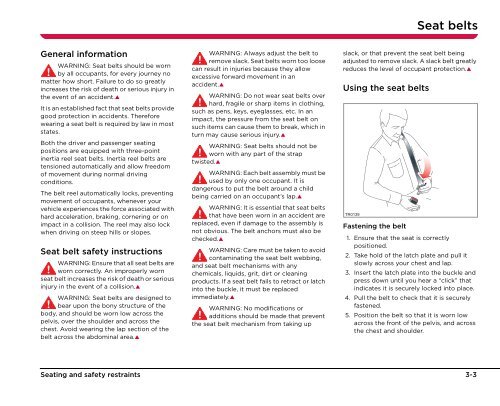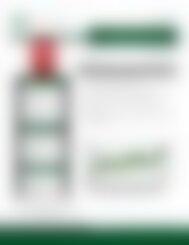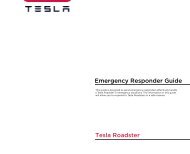You also want an ePaper? Increase the reach of your titles
YUMPU automatically turns print PDFs into web optimized ePapers that Google loves.
Seat belts<br />
Seat belts<br />
General information<br />
WARNING: Seat belts should be worn<br />
by all occupants, for every journey no<br />
matter how short. Failure to do so greatly<br />
increases the risk of death or serious injury in<br />
the event of an accident.<br />
It is an established fact that seat belts provide<br />
good protection in accidents. Therefore<br />
wearing a seat belt is required by law in most<br />
states.<br />
Both the driver and passenger seating<br />
positions are equipped with three-point<br />
inertia reel seat belts. Inertia reel belts are<br />
tensioned automatically and allow freedom<br />
of movement during normal driving<br />
conditions.<br />
The belt reel automatically locks, preventing<br />
movement of occupants, whenever your<br />
vehicle experiences the force associated with<br />
hard acceleration, braking, cornering or on<br />
impact in a collision. The reel may also lock<br />
when driving on steep hills or slopes.<br />
Seat belt safety instructions<br />
WARNING: Ensure that all seat belts are<br />
worn correctly. An improperly worn<br />
seat belt increases the risk of death or serious<br />
injury in the event of a collision.<br />
WARNING: Seat belts are designed to<br />
bear upon the bony structure of the<br />
body, and should be worn low across the<br />
pelvis, over the shoulder and across the<br />
chest. Avoid wearing the lap section of the<br />
belt across the abdominal area.<br />
WARNING: Always adjust the belt to<br />
remove slack. Seat belts worn too loose<br />
can result in injuries because they allow<br />
excessive forward movement in an<br />
accident.<br />
WARNING: Do not wear seat belts over<br />
hard, fragile or sharp items in clothing,<br />
such as pens, keys, eyeglasses, etc. In an<br />
impact, the pressure from the seat belt on<br />
such items can cause them to break, which in<br />
turn may cause serious injury.<br />
WARNING: Seat belts should not be<br />
worn with any part of the strap<br />
twisted.<br />
WARNING: Each belt assembly must be<br />
used by only one occupant. It is<br />
dangerous to put the belt around a child<br />
being carried on an occupant’s lap.<br />
WARNING: It is essential that seat belts<br />
that have been worn in an accident are<br />
replaced, even if damage to the assembly is<br />
not obvious. The belt anchors must also be<br />
checked.<br />
WARNING: Care must be taken to avoid<br />
contaminating the seat belt webbing,<br />
and seat belt mechanisms with any<br />
chemicals, liquids, grit, dirt or cleaning<br />
products. If a seat belt fails to retract or latch<br />
into the buckle, it must be replaced<br />
immediately.<br />
WARNING: No modifications or<br />
additions should be made that prevent<br />
the seat belt mechanism from taking up<br />
slack, or that prevent the seat belt being<br />
adjusted to remove slack. A slack belt greatly<br />
reduces the level of occupant protection.<br />
Using the seat belts<br />
TR0139<br />
Fastening the belt<br />
1. Ensure that the seat is correctly<br />
positioned.<br />
2. Take hold of the latch plate and pull it<br />
slowly across your chest and lap.<br />
3. Insert the latch plate into the buckle and<br />
press down until you hear a “click” that<br />
indicates it is securely locked into place.<br />
4. Pull the belt to check that it is securely<br />
fastened.<br />
5. Position the belt so that it is worn low<br />
across the front of the pelvis, and across<br />
the chest and shoulder.<br />
Seating and safety restraints<br />
3-3







